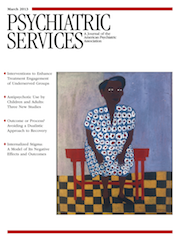This Month’s Highlights
Better Engagement to Reduce Disparities
Engaging patients in mental health treatment can be seen as series of linked steps—from encouraging individuals to seek care to ensuring that they remain in treatment long enough to receive an effective “dose.” A broken link often means a poor clinical outcome. Because research has consistently shown that the current system is less effective at engaging members of underserved racial-ethnic minority groups, strengthening engagement is an appropriate target for reducing disparities. In the lead article, Alejandro Interian, Ph.D., and colleagues report findings from a review of current interventions that employ strategies to enhance engagement. The systematic review found ten randomized trials in which patients from underserved racial-ethnic groups made up at least half the sample. Collaborative care for depression was the only approach that could be designated as efficacious for engagement. Ingredients include patient choice of a primary care–based treatment, use of a depression care manager who monitors symptoms and adherence, and psychiatrist consultation with the primary care physician. The review found many problems with the design of recent studies—problems that were highlighted more than a decade ago in the Surgeon General’s report on culture, race, and ethnicity and that, as the authors note, “curtail our ability to assess the evidence base for improving engagement among the very populations who are disproportionately affected by this issue” (page Original article: 212). In Taking Issue, Jo Anne Sirey, Ph.D., describes the challenge of “embracing engagement with all its complexity” and the need for investigators to build strong partnerships with other community providers (page Original article: 205).
Pediatric Antipsychotic Use, 1997 and 2006
A recent study of Medicaid claims data has confirmed the marked increase in pediatric use of antipsychotics. Analyzing 1997 and 2006 data for more than 450,000 youths in a mid-Atlantic state, Julie Magno Zito, Ph.D., and colleagues found that the prevalence of antipsychotic use grew from 1.2% to 3.2%. The authors took a closer look at their data to uncover factors related to Medicaid eligibility and psychiatric diagnosis to account for the growth. Even though 2006 rates of antipsychotic use were lower among youths who were Medicaid eligible because of low and very low family income than among youths who were eligible because of disability, the substantial growth in the income-eligible groups (State Children’s Health Insurance Program and Temporary Assistance for Needy Families) accounted in large part for the growth in antipsychotic use—20% of antipsychotic users in 1997 and 46% in 2006. Use of these drugs to treat externalizing behavior symptoms has also been paramount, the authors note. Treatment of pediatric bipolar disorder, attention-deficit hyperactivity disorder, and disruptive disorders with antipsychotics grew threefold in this study population. Youths with these conditions far outnumbered those with schizophrenia, other psychotic disorders, and pervasive developmental disorders, who had the highest rates of antipsychotic use (page Original article: 223).
Race-Ethnicity and Clozapine’s Efficacy
Despite evidence of its efficacy, clozapine is underused in the routine care of U.S. patients with schizophrenia, particularly among those from racial-ethnic minority groups. Race-ethnicity plays a role in how some medications are metabolized, resulting in lowered effectiveness, but this type of comparative effectiveness research is mostly lacking for clozapine. Marcela Horvitz-Lennon, M.D., M.P.H., and colleagues looked for evidence of compromised effectiveness of clozapine among black and Latino Medicaid beneficiaries in Florida who were receiving maintenance antipsychotic treatment. Using time to medication discontinuation as the primary measure of effectiveness, the investigators found that although the overall risk of antipsychotic discontinuation was higher for blacks and Latinos than for whites, the risk of discontinuation was lower for clozapine users—an effect that was not moderated by race-ethnicity. “The findings highlight the need for efforts to increase clozapine use, particularly among minority groups,” the authors conclude (page Original article: 230).
Briefly Noted . . .
| •. | Although cardiometabolic risks linked to some antipsychotics should be a factor in prescribing decisions, a survey at a Veterans Affairs medical center found that such considerations played neither a robust nor consistent role in clinician’s prescription of these agents (page Original article: 238). | ||||
| •. | Is recovery an outcome or a process? The author of the Open Forum describes competing constructs of recovery that threaten to derail the widespread implementation of recovery services (page Original article: 270). | ||||
| •. | Fidelity monitoring of assertive community treatment (ACT) programs is important to ensuring good outcomes. But it is resource intensive, involving onsite visits by independent assessors. In this pilot study, ACT teams used a self-report protocol to gather needed assessment data themselves (page Original article: 272). | ||||



